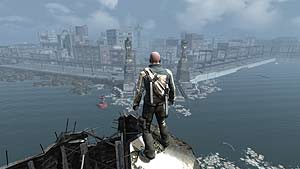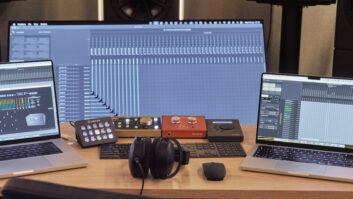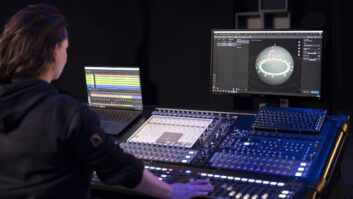
A bomb detonates in the heart of Empire City, obliterating several blocks and leaving a huge crater in its wake. Miraculously, bike messenger Cole McGrath, who was unwittingly transporting the bomb, is not killed; when he awakes from a coma two weeks later, however, he finds that he has strange new electrical powers. Those will come in handy because he is being blamed for the blast, and it seems like everyone in the city — parts of which have been overrun by a murderous street gang, while other parts are quarantined because of a plague outbreak — is after him!
That is the basic premise of the exciting new PlayStation 3 videogame InFamous, developed by Sucker Punch Productions and published by Sony Computer Entertainment America. This third-person “sandbox” (open-world) game follows McGrath as he runs and fights his way through the city, aided by a couple friends. His “missions” take him to all sorts of strange and dangerous places and bring him into contact with a rogue’s gallery of desperate characters bent on mayhem. Does McGrath want revenge or redemption? The game can be played both ways.
Visually, the game is a wondrous achievement, with an amazingly gritty and detailed cityscape to explore. And the cinematics — which advance the story and set up the game-play — are bold and unique, with a sort of 3-D comics/graphic-novel imagery that feels completely complementary. InFamous also features an intriguing multistyle musical score that really gets the heart racing: It helps establish the dark, mysterious ambience of Empire City and heightens the action at every turn. It is this aspect of the game’s production that brings us down to SCEA’s Foster City, Calif., studios (south of San Francisco) on a sunny spring afternoon.
SCEA’s involvement with the music for InFamous began in 2007, when senior music manager Clint Bajakian and music manager Jonathan Mayer met with a team working on the game up at Sucker Punch in Seattle. “At that stage,” Mayer says, as he sits in the control room of SCEA’s studio complex, “the game was still being put together. We had concept art, we had a script in PowerPoint form that we were able to look at with Nate Fox, who’s the creative director on the game, and at that time they had temp music all over the parts of the game that were playable, mostly in the form of big beats; no harmony, no melody — just big Taiko drums, hand drums, things like that. They were really in love with that; they thought it was great, and so did we. We put it up against game-play and there was really no argument that this worked. So the immediate task was, based on that, figuring out how to do something really original and creative [with percussion].
“So Clint and I went out to dinner and the idea came up: What if we actually honored that idea of basic tribal beats, but we did it with other instruments, so instead of a Taiko drum, we had a guy banging on a dumpster? And we started hashing out this idea of using found objects to re-create what they had done with their temp music, and also come up with something that was harsher, more desperate-sounding, a lot grittier and tugging at people more.”
Then, Bajakian adds, “Jonathan got the idea of sending up some music by Amon Tobin, and that was received very positively by the team up there, and we contacted Amon and he got excited about the project right away, which was very gratifying to us.” While not well known in pop music circles, the Brazil-born Tobin has a huge following in electronica/trip-hop/experimental music genres. He created the soundtrack for the third game in the Splinter Cell Series (Chaos Theory) and has contributed music to such films as The Italian Job and 21. In recent years, he’s become acclaimed for his creative use of sampling, and his latest CD, Foley Room (2007), was pieced together from a veritable ocean of different samples.

InFamous sound team, standing (L-R): Joel Yarger, Michael Bricker, Matt Levine, Ernest Johnson, Marc
Senasac. Seated: Clint Bajakian, Jonathan Mayer, Chuck Doud, Scott Hanau.
Tobin would turn out to be the lynchpin in a close-knit, highly collaborative music team put together by Mayer, which also included the award-winning TV/film/game composer Jim Dooley, British composer and ambient score designer Mel Wesson, and the innovative electric cellist Martin Tillman, whose work has graced such soundtracks as Blackhawk Down and Ali. Mayer also wrote upwards of 40 minutes of music and, with producer Bajakian, performed on some of the percussion tracks that were sampled and altered by Tobin. Chuck Doud, director of music at SCEA (and a former game composer himself), was the benevolent overseer and financial manager of this adventurous project, which stretched the in-house team in ways that it never had been before.
“More and more,” Doud comments, “we sort of modularly let [the music tracks] grow as we go, because we can all have ideas for what we want and what we think is going to work, but until you really start hearing your ideas come to fruition and get them in the game, you don’t know exactly where you want to go with it. That’s why, if we bring on multiple composers for a project, or even just one or two, we won’t immediately contract out all the minutes we need for the game. We’d rather let it evolve organically. And that’s exactly what happened with InFamous. For us, InFamous was an opportunity to break new ground with regards to how the music was produced. The aesthetics of the game were so unique and compelling, and it challenged us in so many ways. There was a lot of cross-pollination going on between all the composers.”
The first order of business for the music team — before Tobin or any of the others had been brought in — was to do field recordings with a portable rig of “found objects” in various locales, including a scrap yard where cars were being crushed and another that was filled with sundry metal items. Mayer explains, “I took a bag full of mallets and a metronome and started recording grooves on car parts and old radiators — anything we could find, including some of the machinery they were using for crushing cars. There was an old streetlamp that we played with all sorts of different things, like rubber xylophone mallets. It was 15 or 18 feet long, so we’d put a mic at one end and then do runs up and down. So that became like a pad. Then we found this big piece of steel that had these cubby holes for an office mailroom, and we put the mics on one side and guys with sticks would tap on the other side, and it sounded like a whole bunch of guys drumming.
“When we came back from that recording session,” Mayer continues, “we set ourselves to work setting up a sample library, not thinking too much about the cues or the pieces of music we were going to make, and we just tried to find things that were useful and cut them up and organized them nicely. At that time we had just contracted Amon, and we told him we’d gone out and done this recording and he said, ‘Give me all that stuff!’ I was trying to clean it up, but he said, ‘No, give me everything you’ve got; don’t mess with it!’ The way he approached those first few cues — and it actually carried throughout the game — really blew us away because it was amazing how refined and musical a sound came back to us. They were finished, glorious pieces of music. He did a really good job of adding some analog synth sounds that really complemented these stark metallic and percussive sounds. A lot of it was in the arranging and the way he laid things out — he did an amazing job of leveraging the space in these sounds.”
Next, Mayer and Bajakian decided to shift the focus of their percussion experiments to SCEA’s studios. The company’s recording complex comprises a warren of smallish 5.1 rooms that allow everything from tracking to mixing to editing to voice-over. “With more home theaters out there and a lot more emphasis on high-quality audio, it’s no longer about pumping videogame audio over TV, and we take that very seriously,” Bajakian comments as he sits in the Chris Pelonis-designed control room. The studio is equipped with a Digidesign D-Command console, scads of great outboard gear, multiple video screens and a truly formidable 7.1 setup — with huge loudspeakers designed by Pelonis and built by Tannoy. “At Sony, [director of services groups] Dave Murrant, Chuck Doud and [director of tools, technology and services] Buzz Burrowes worked to put the budget together and worked with Chris Pelonis to create a set of facilities that are consistent from room to room. We have whole hallways of editing suites that correspond sonically to this main room — the speakers are smaller but they’re custom-made by Chris and Tannoy to deliver very flat frequency response and they’re very consistent. We’ve found that what we mix and master in these rooms translates great to automobiles and home theaters and stereos and boom boxes alike.” Not surprisingly, Pro Tools is the recording format of choice here; there are rigs in every studio room.
Mayer and Bajakian turned the tracking space adjoining the control room into a veritable percussion jungle. In keeping with the spirit of the field recordings, most of the “instruments” that were tapped, banged, shaken, beaten and bowed were not conventional drums, but other objects — from trash cans, to plastic buckets, to boxes of broken china. And then there were musical instruments that became percussion devices.
“We suspended a cello horizontally and took a cello bow and started doing things that were probably way out of line,” Mayer says with a laugh, “violating this cello, bowing across the bridge and beating on it with drumsticks and creating a collection of samples that became the basis for a really great, intense combat piece that Amon created early in the project. I also spent a lot of time with Clint, with Amon producing us, banging on a Chinese zither called a guzheng or a zheng, which we had here in the studio. We had no idea how to actually play it, so I had drumsticks and I was playing a pattern on one side of the instrument, and Clint was on the other side bending the strings in time, so we had this little duet of this bendy percussive thing, and Amon made that the basis for the whole section [in the game] where Cole is going back into the city. Then, in one of the combat pieces, instead of an action hi-hat [pattern], Amon used recordings of me playing on a concert euphonium that’s suspended — I’m playing it with wire brushes and dowels and things like that. It’s a brass instrument being abused. We had a concert bass drum and Amon got us to turn it on its side and string bungee cords across it and play the bungee cords instead of the bass drum, and record the bottom of the bass drum while we were doing it.” They also recorded the sound of peas rattling across the surface of the drum. “We weren’t concerned with realism; we were concerned with getting freaky, cool sounds. Amon drove a lot of that.
“For us, collaboration is a big deal,” he continues. “We felt like we hit a gold mine early on [with the composers]. When you get all those machines turning in unison, you get something that is way greater than the sum of its parts. Not only were Amon, Jim Dooley, Mel Wesson and Martin Tillman willing to work together, they were hungry for it, so when things started to gel and come together and we started to hear the results of assets being passed back and forth — usually through us — all these unusual things started happening musically.”
Bajakian also lauded “the intense collaboration, where everyone put aside their egos and instead wanted to work with each others’ materials, handing things around like they were balls in a rugby match. For example, Jim Dooley got the idea to record the Prague Strings doing a whole bunch of loose aleatoric gestures; things that were often dissonant: Start at the top of your string and slide your finger down slowly, get loud in the middle and then taper off. Things like that — effects. He had a whole library of effects and he shared them with everyone on the project — Jonathan used them in some of his compositions; Amon used them in some of his.”
But let’s not forget that this isn’t just an exercise in producing cool, unique music. As Chuck Doud observes, “We could produce as much awesome music as we want, in almost any style, but translating that into the experience of the player that enhances his game-play is a completely different challenge.”
Indeed, ultimately it was up to Bajakian, Mayer, and various editors and implementers — spearheaded by Scott Hanou — to make the music work within the game. Mayer notes that though a lot of the music that Tobin delivered went into the game as he delivered it, at SCEA they also sometimes edited and altered the stems the composer delivered, “whether it was to fit a scene or make it behave in an interactive manner. We’d create layers out of the piece of music and then have high, medium and low-intensity layers within a single piece of music that the game engine drives, depending on the intensity of the scene.
“We also might tell the editor to take a piece of music and ‘taffify’ it — turn a two-minute combat piece into a four- or five-minute piece that loops with a lot more peaks and valleys than it had when the composer turned it in,” Mayer continues. “So we’ll poke holes in it, we’ll tweak the arrangement and do whatever needs to be done. Then, in the actual game engine, we have playlists, so when you get to a checkpoint in a mission, we make a certain number of pieces of music available, and if the player ‘dies’ and restarts at that checkpoint, the playlist progresses to a different piece of music or it might be a different version of the same piece. For us, the worst thing in the world is for the music to be noticed negatively. It’s got to be part of the world and part of the experience and part of the emotion.”
Adds Doud, “Sometimes you want the player to know the music’s changed, but sometimes you don’t want them to know; you don’t want to pull them out of the experience. So the challenge is to have this music composed and arranged and produced and integrated into the game where you’ve got this system running under the hood that is pulling pieces in and out on the fly depending on what’s going with the game-play, but it’s not interfering with the player’s experience.”
Of course, the musical soundtrack is just one key ingredient in making InFamous such an inviting and exciting PlayStation 3 experience. Other parts of the game audio were handled by other teams in other cities — from sound effects and Foley (the San Diego post group led by Mike Johnson) to dialog recording (in L.A. and New York).
The final sound mix took place over a period of several weeks at Sucker Punch in Seattle, and involved creative director Nate Fox, SCEA sound design manager Ken Felton, Sucker Punch audio director Andy Martin and Mayer. “We actually turned down the music in a few places,” Mayer says. “We wanted to make sure the music stayed out of the way of the dialog.”
No worries. There’s still hours of visceral, eerie, disturbing, mind-bending and atmospheric music in the game. And, predictably, there is also a music-only soundtrack available for gamers to enjoy away from the PlayStation 3 console, as well — edited versions and cleverly constructed pastiches of different cues, plus the end credit’s song, “Silent Melody” by Working for a Nuclear Free City.
“Players become passionate about the music because they live with it for 20, 50, 100 hours, and if it’s done right, it’s an integral part of their experience,” comments Doud. “Does that translate to them wanting to sit in their car and listen to the music they’ve been listening to for the last few weeks? Maybe, maybe not. But if we can offer them something that’s authentic to what they experienced in the game but a little different, something that can continue and expand the music experience, that takes itto a whole other level.
“We’re not going to play it safe,” Doud concludes. “We think the only way you can be better and break new ground is to take chances. We’re in a very fortunate position here where we have an incredibly talented department. They’re the best at what they do, and operating from that position gives you the ability to have more confidence and take more risks. Besides, taking risks is always more fun than playing it safe.”







